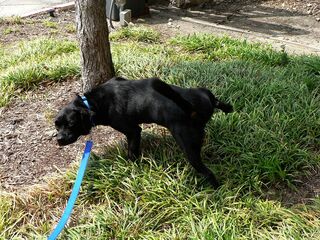Anxiety
Let Dogs Be Free to Poop and Pee
Meeting the behavioral needs of dogs related to elimination.
Posted May 10, 2022 Reviewed by Abigail Fagan
Key points
- One of the most severe constraints we place on dogs—and one that hasn’t received much discussion—is over their bodily processes of elimination.
- We need to think about poop and pee from our dog’s point of view, rather than from a human perspective.
- Peeing and pooping are social events for dogs, not private business.

I’ve spent many years researching and thinking about the ethical contours of human-dog relationships, especially the relationship formed when we bring a dog into our home and “ask” him or her to be our pet. One of the most significant ethical problems with keeping dogs as pets is the almost complete loss of agency or control experienced by dogs within the home environment. Indeed, one of the defining features of life for pet dogs is that they cannot control, for themselves, the basic goods necessary for access to food and water, access to social interactions and to a social network, and access to the world outside the four walls of our home.
One of the most severe constraints we place on dogs—and one that hasn’t received much discussion—is over their bodily processes of elimination. Perhaps second only in importance to control over their access to food is our control over when, where, whether, and how pet dogs can empty their bladder and bowels. Elimination behaviors are important not only to our dog’s physical health but also to their mental well-being. Dogs likely feel some anxiety related to elimination, given that they often cannot go based on the needs of their body but must follow a schedule set by us. Not only that, but we may also fail to understand that dogs have a whole suite of behavioral needs related to elimination that go well beyond emptying their bladder and bowels.
Freedom to Pee and Poop
A minor but growing thread within human rights literature concerns the connection between toilets and freedom. The ability to manage, for oneself, the bodily functions of urination and defecation is critical to human dignity. Having some measure of control over bodily functions is critical to dog dignity, too, though for slightly different reasons.
In addition to loss of freedom over this basic life-relevant decision, we may impose discomfort on dogs by making them “hold it” for uncomfortable periods of time. Anyone who has ever needed a bathroom urgently and hasn’t had immediate access will understand how uncomfortable and anxiety-provoking this is. Having to “hold it” is not only stressful but can also cause gastrointestinal problems, including chronic constipation. Constraints on basic bladder and bowel functioning are especially hard for dogs who are sick or who, as they age, have more frequent elimination needs.
How can we help our dogs feel a greater sense of control over this most basic activity of daily living? Perhaps the best-case scenario is a dog door into a fenced yard or safe open space, which allows dogs to make their own choices and relieve themselves whenever nature calls. But dog doors aren’t always a viable option. An alternative is to take our dog outside more frequently. Yet another way to increase control is to teach our dog to ask to go out. My friend Jane’s dog uses her nose to ring a small bell hanging from the doorknob to ask to go pee.
Scratch and Sniff
When it comes to poop and pee, there is a tendency to boil things down to the physiological process of eliminating bodily waste products. But just as feeding is about more than the physical contents of a bowl of kibble, elimination behaviors encompass much more than simply being able to empty the bladder and bowels.
We humans think of using the toilet as a very private affair, and so we may not readily understand how different it is for dogs. For dogs and other canids, poop and pee are highly social, highly communicative activities relating, among other things, to territory, reproduction, social relationships, and activity patterns. Dogs need more than just a scrap of grass and a quick second.
Here are just a few things dogs might be doing when they are doing their business. Urine contains a great deal of salient information for dogs, so when they pee they are leaving messages for other dogs who might come by. Like graffiti, urine leaves a mark: “Thomas was here.” Pee might communicate information about reproductive status, emotional state, what Thomas had for breakfast, or many other things beyond the ken of human understanding. In Unleashing Your Dog, Marc Bekoff and I refer to urine as “pee-mail” because of its communicative potential.[i]
Where dogs choose to pee is not typically random nor do they necessarily want to pee in the places we choose for them. They may want to overmark on the pee of another dog, or they may want to start a new message chain. Indeed, it isn’t only where dogs pee, but also how they pee. Male dogs lifting a leg high are giving a visual signal. As Bekoff found in his research, sometimes dogs use the visual signal of leg lifting without depositing any pee.[ii] Poop, likewise, sends messages to other dogs and animals. The reason that dogs sometimes scratch the ground after pooping is to accentuate the communication both visually and olfactorily. Peeing and pooping are intimately related to sniffing. When dogs sniff the pee and poop left by other dogs, they are busy “reading” the pee-mail and poo-mail messages.
I had a reporter ask me several months ago if I knew when doggie pee pads and fake turf came into existence. And was it wrong, she asked, to make a dog pee on a strip of AstroTurf inside an apartment? I couldn’t answer the question about when fake turf became a thing, but I suspect that these products entered the mainstream quite recently, over the past two decades. They are part of a trend toward increasingly intensive homing of dogs. More and more dogs are now “indoor only,” living like intensively homed cats with litter boxes. As for the reporter’s ethics question, my answer was yes. I do think it is wrong to make a dog “go” indoors only and to thereby reduce the complex suite of elimination behaviors to a bland, isolated, un-doglike experience. It is just one more step in the process of de-dogging our dogs, bit by bit taking away pieces of their natural behavioral repertoire.
Re-dogging Our Dogs
A shift in perspective is all we need. We need to think about poop and pee from our dog’s point of view, rather than from a human perspective. We can then take steps to widen the behavioral options available to our dogs and, in turn, make their lives more interesting.
Here are six simple things you can do to expand your dog’s elimination horizons:
- Take them outside more often. No matter how many times a day we take our dogs out, more will probably be better. They will have greater opportunity to eliminate when nature calls, rather than having to hold it.
- Remember that peeing and pooping are social behaviors, so at least some of the time we should let our dogs do their business somewhere other than the backyard. All those pee- and poo-mail messages shouldn’t go to waste. An important corollary here is that we also need to be responsible about carrying poop bags and picking up after our dogs.
- Let them sniff. Sniffing is intimately related to peeing and pooping. Given the choice, most dogs will spend about a third of their time on a walk engaged in sniffing. If our dogs are interested in sniffing pee and poop left by other dogs, let them! It isn’t going to make them ill, it isn’t gross in dog culture, and they will find it very interesting.
- Let them scratch. For some dogs, scratching after they poop is an important part of the process, like hitting “send” on the poo-mail message.
- Let them take their time. The temptation, when we are standing out on the front step in the bitter cold in our bare feet waiting for our dog to pee before we go to bed, is to become impatient and command them to hurry up and get busy. But at least some of the time we should let them be outside without feeling pressure.
- Teaching a dog to pee on cue (“get busy” or “do your business”) adds a valuable skill to their toolbox. But use the command sparingly, and only when necessary. Otherwise just let them be free to pee.
References
[i] Bekoff and Pierce, Unleashing Your Dog.
[ii] “Scent marking by free-ranging domestic dogs: Olfactory and visual components.” Biology of Behavior, 4, 123-139. See also Marc Bekoff's Psychology Today post, "Pissing matches in dogs": https://www.psychologytoday.com/us/blog/animal-emotions/201704/pissing-….




